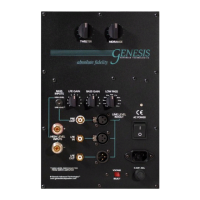ver 1.3
22
2222
22
~ÄëçäìíÉ=ÑáÇÉäáíó
The woofers are a uniquely designed metal cone driver made for the
Genesis servo system. Made of a cone of solid aluminium, the
suspension and voice-coil have been maximized for long, distortion-free
excursion so as to increase dynamic range. Our aluminium cones are a
magnitude stiffer than plastic or paper cones, and virtually eliminate the
problems caused by cone bending and break-up.
The lowest break-up mode (where there can be any chance of distortion
at all), is at 6,000Hz – far above the 16Hz to 180Hz frequency range
that these woofers operate at. Therefore, the driver is a perfect piston
within the frequencies used. Thus, low cone break-up distortion is
inherent in the woofer.
Unlike the mid-bass couplers, midrange and the tweeters, which operate
in dipole, the two woofers in the G6.1 operate in-phase as a dipolar
counter-firing balanced pair. Hence, they are configured to deliver the
highest SPLs as well as the least vibration in the cabinet.
All four woofers in a pair of G6.1’s work in-phase to control the air mass
of the listening room. This means that the surface area of the four cones
and the loudspeaker enclosure all work in unison to produce bass
output that descends evenly to below your hearing limits.
6.4 500 watt Class D Servo Amplifier
While the advantages of metal cones include extreme stiffness resulting
in very low distortion and break-up, one problem is that of greater mass.
The servo system also places extraordinary demands on the amplifier
because the system uses enormous amounts of current to make the
woofer follow the input signal. Combined with the metal cones, this
means that the amplifier used must deliver extraordinarily large amounts
of clean power.
To overcome this, Genesis had to build an amplification system of great
wattage and high damping factor. In the G6.1, the built-in amplifier was
specifically designed and tuned for low frequencies in order to produce
“floor-shakingly musical” bass signal to power the servo woofers.
The problem with conventional power amplifiers is that they generate a
lot of heat. This is because a lot of electricity is wasted in keeping the
transistors on idle, and then channelling power to the drivers. The Class-
D amplifier is a switching amplifier. In the simplest terms, it is like a tap –
it turns on and off to send electrical energy from the electrical mains to
the transducer. This makes it highly efficient, and hence it doesn’t need
big storage capacitors and heat sinks like the conventional amplifiers
that you know only too well.

